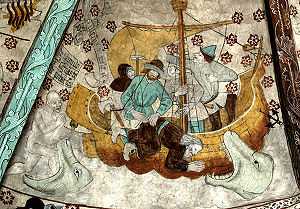Church frescos in Sweden

Church frescos or church wall paintings (Swedish: kalkmålningar) are decorative paintings, mostly medieval, found in several Swedish churches where they adorn the vaults and sometimes walls of the buildings. Paintings survive in both wooden and stone churches. At least 444 such church frescos survive to this day,[1] only a fraction of the original number; churches in Sweden during the Middle Ages were not considered complete until they were decorated internally with such frescos.[2] Today, the rich heritage of church frescos in Sweden has been described as a unique treasure.[3] While some have been covered with whitewash during later centuries and laboriously uncovered and restored, others have stayed untouched for centuries. The well-preserved status of many of the frescos can be attributed to the fact that the Lutheran reformation was not ubiquitously iconoclastic in Sweden, and to the relative absence of wars on Swedish soil.[2][3]
History
The oldest church frescos in Sweden date from the early 12th century; few of these have survived.[4] The artists who painted these frescos probably came from present-day Denmark and Germany.[5] The first frescos were in Romanesque style, with Gothic influences arriving circa 1250.
Geographical distribution
Most of the oldest church frescos in Sweden are found in the south of the country.[4] Of early and high Gothic frescos, frescos from circa 1250-1300 are preserved mainly in Scania (which was at the time a part of Denmark) and on Gotland. Late Gothic frescos are represented mainly in Östergötland, Scania and Uppland, although examples can be found throughout most of the country.[2]
Artists
Rather little is known about who the so-called masters or artists who executed the decorative paintings were. At least during the late medieval period, some artists seem to have been based in cities, working in the surrounding area. Known examples include those based in Stockholm, Linköping and Arboga. Most artists are not known by name and have only in later ages been assigned attributional pseudonyms, such as the Snårestad Master or the Risinge Master, both named after churches in which their frescos survive, or the Master of the Passion of Christ, named after the artist's favourite subject matter. In other cases the names of artists are known from documents in city archives, but it is not certain which churches they decorated. Still, a few artists with attributable works are known by name. Some signed their work, with runes or letters. During the later Middle Ages, the painters often dated their work.[2]
Most of the signed work dates from the 15th century. Identifiable artists who have signed their work in this period include Johannes Iwan, Andreas Eriksson, Erik Östensson, Nils Håkansson, Albertus Pictor and Johannes Rosenrod.[2]
See also
| Wikimedia Commons has media related to Frescos in Swedish Churches. |
References
- ↑ "Sökguide". Medeltidens bildvärld (in Swedish). Swedish History Museum. Retrieved 28 December 2013.
- ↑ 2.0 2.1 2.2 2.3 2.4 Lindgren, Mereth (1996). Signums svenska konsthistoria. Den gotiska konsten. (in Swedish). Lund: Signum förlag. pp. 309–412. ISBN 91-87896-25-7.
- ↑ 3.0 3.1 "Kalkmålningar". Medeltidens bildvärld (in Swedish). Swedish History Museum. Retrieved 28 December 2013.
- ↑ 4.0 4.1 "Kalkmålningarna i Sverige". Medeltidens bildvärld (in Swedish). Swedish History Museum. Retrieved 28 December 2013.
- ↑ "Vem målade bilderna?". Medeltidens bildvärld (in Swedish). Swedish History Museum. Retrieved 28 December 2013.